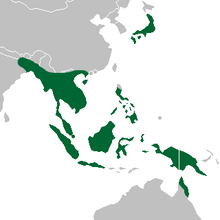Apostasia (orchids)
| Apostasia | ||||||||||||
|---|---|---|---|---|---|---|---|---|---|---|---|---|

Apostasia wallichii , illustration |
||||||||||||
| Systematics | ||||||||||||
|
||||||||||||
| Scientific name | ||||||||||||
| Apostasia | ||||||||||||
| flower |
Apostasia is a genus from the family of the orchid (Orchidaceae). It consists of eight to nine types of herbaceous plants that are native to tropical Southeast Asia.
description
The species of the genus Apostasia form a creeping rhizome , which is surrounded by dry lower leaves. The roots are thin, surrounded by Velamen radicum , they form small, rounded tubers. The roots arise not only along the rhizome, but also from the above-ground shoot, where they break through the leaf bases.
The ascending, sometimes branched shoots carry the leaves in a loose rosette or evenly distributed on the shoot. The leaves are lanceolate to narrow oval in shape. The leaf base runs in a wedge shape into an indistinct petiole that encompasses the shoot and completely covers it. The leaf blade is quite smooth and not wrinkled along the vein. At the tip of the leaf, the leaf margins have grown together to form a thin tube.
The mostly branched, sloping to drooping inflorescence appears terminal. The bracts are significantly shorter than the ovary . The short flower stalk merges seamlessly into the long, narrow ovary. The flowers are not resupinated . The petals are free, of a fleshy texture, slightly curved in the shape of a boat and colored white, cream or yellow. Sepals and petals hardly differ, and a specialization of a petal as a lip is hardly noticeable, the flowers are approximately radial symmetry. The column arises from the stamens and styles that have grown together on the ground . There are two fertile stamens and, in some species, a third sterile one ( staminodium ). The resulting capsule fruit is cylindrical in shape with three longitudinal ribs.
Occurrence
Apostasia is common in tropical Southeast Asia. The northern limit of distribution runs from northeast India through southern China. A disjoint, even further north located occurrence is on the Japanese Ryūkyū Islands . To the southeast, the area stretches across back India , Indonesia, the Philippines to New Guinea and northeast Australia. An area in Sri Lanka is also disjoint. Apostasia species occur from the seashore up to an altitude of about 1700 meters. Apostasia wallichii is the most common species.
The locations are mostly in the shade of evergreen, moist forests.
Systematics and botanical history
Together with the genus Neuwiedia, Apostasia forms its own subfamily within the orchids, the Apostasioideae . This subfamily is the sister group to all other orchids. Two sections can be distinguished within the genus, the Apostasia section with an existing staminodium and the Adactylus section without staminodium.
The genus Apostasia was established by Carl Ludwig Blume in 1825 . The type species is Apostasia odorata . The name Apostasia comes from the Greek and means “difference” or “divorce”, which should indicate the differences to the other orchids.
The following species are included in Apostasia :
- Apostasia elliptica J.J.Sm. : According to WCSP, it is a synonym of Apostasia latifolia .
- Apostasia fogangica Y.Y.Yin, PSZhong & ZJLiu : This species, first described in 2016, occurs in the Chinese province of Guangdong .
- Apostasia latifolia Rolfe : It occurs in Malaysia, Sumatra and Borneo.
- Apostasia nipponica Masam.
- Apostasia nuda R.Br. : Assam to western Malesia.
- Apostasia odorata flower : Arunachal Pradesh to southern China and Malesia.
- Apostasia parvula Schltr. : It occurs in Borneo.
- Apostasia ramifera S.C. Chen & KYLang : It occurs in southwestern Hainan.
- Apostasia shenzhenica Z.J.Liu & LJChen : The species first described in 2011 occurs in the Chinese province of Guangdong .
- Apostasia wallichii R.Br. : It occurs from China to tropical Asia and northern Australia and also in Japan.
supporting documents
Most of the information in this article comes from:
- Alec M. Pridgeon, Phillip J. Cribb, Mark W. Chase, Finn N. Rasmussen (Eds.): Genera Orchidacearum. General Introduction, Apostasioideae, Cypripedioideae . tape 1 . Oxford University Press, New York and Oxford 1999, ISBN 0-19-850513-2 , pp. 100-104 .
- Chen Xinqi, Zhu Guanghua, Ji Zhanhe, Lang Kaiyong, Luo Yibo, Phillip Cribb: Orchidaceae . In: Wu Zhengyi, Peter H. Raven (Ed.): Flora of China . tape 25 . Missouri Botanical Garden Press, St. Louis ( efloras.org [accessed November 14, 2009] 1994+).
- EF de Vogel: Monograph of the Tribe Apostasieae (Orchidaceae) . In: Blumea . tape 17 , no. 2 , 1969, p. 313-350 .
Individual evidence
- ↑ CL Blume: Bijdragen tot de flora van Nederlandsch Indië . tape 8 , 1825, p. 423 ( botanicus.org ).
- ↑ Rafaël Govaerts (ed.): Apostasia. In: World Checklist of Selected Plant Families (WCSP) - The Board of Trustees of the Royal Botanic Gardens, Kew .
- ↑ a b c d e f g h i j Rafaël Govaerts (Ed.): Apostasia. In: World Checklist of Selected Plant Families (WCSP) - The Board of Trustees of the Royal Botanic Gardens, Kew . Retrieved May 7, 2020.
- ↑ According to Kew Checklist a synonym for Apostasia wallichii , according to de Vogel (1969), Kocyan u. a. (2004) and Yukawa et al. a. (2009) independent Art
